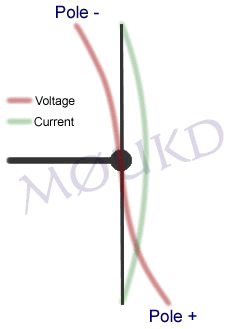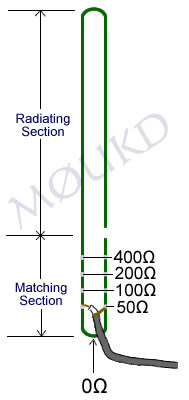 |
| Clansman PRC 351. |
 |
| Philips RT 4600/VRC. |
Before World War II, British radio amateurs had been allocated a band at 56 Mhz. After the war ended, they were allocated the 5-meter band (58.5 MHz to 60 MHz) instead. This only lasted until 1949, as by then the 5-meter band had been earmarked for BBC Television broadcasts.
In 1956, after several years of intense lobbying by the Radio Society of Great Britain (RSGB), the 4-meter band was allocated to British radio amateurs as a replacement for the old 5-meter band allocation. For several years the 4-meter band allocation was only 200 kHz wide--from 70.2 MHz to 70.4 MHz). It was later extended to today's allocation of 70.0 MHz to 70.5 Mhz.
Allocations:
A chart showing how Television channel frequencies in various countries relate to the 4 meter amateur band.
In addition to the traditional users (United Kingdom, Gibraltar and the British Military Bases in Cyprus), an increasing number of countries in Europe and Africa have also allocated the 4-meter band to radio amateurs as a result of the decline in VHF television broadcasts on the 4-meter band. Movement away from the old Eastern European VHF FM broadcast band and migration of commercial stations to higher frequencies have led to slow but steady growth in the number of countries where 4-meter operation is permitted.
Whilst not formally allocated at an ITU or Regional level, in Europe CEPT now recognizes the increased access to 70 MHz by radio amateurs with footnote 'EU9' which has helped underpin further growth. In July 2015 CEPT updated this footnote to fully recognize it as a formal secondary allocation:
"EU9: CEPT administrations may authorize all or parts of the band 69.9-70.5 MHz to the amateur service on a secondary basis."
In practice this ranges from 70 MHz to 70.5 MHz in the United Kingdom, with other countries generally having a smaller allocation within this window. In most countries the maximum power permitted on the band is lower than in other allocations to minimize the possibility of interference with non-amateur services, especially in neighbouring countries. A table with national and regional allocations is published and regularly updated on the Four Meters Website.
Propagation:
The 4-meter band shares many characteristics with the neighbouring 6-metre band. However, as it is somewhat higher in frequency it does not display the same propagation mechanisms via the F2 ionosphere layer normally seen at HF which occasionally appear in 6 meters, leastwise not at temperate latitudes. However, Sporadic E is common on the band in summer, tropospheric propagation is marginally more successful than on the 6-meter band, and propagation via the Aurora Borealis and meteor scatter is highly effective.
While Sporadic E permits Europe wide communication, it can be a mixed blessing as the band is still used for wide bandwidth, high power FM broadcasting on the OIRT FM band in a declining number of Eastern European countries. Although this has lessened in recent years, it can still cause considerable interference to both local and long distance (DX) operation.
First ever trans equatorial propagation (TEP) contact on 70 MHz took place on 28 March 2011 between Leonidas Fiskas, SV2DCD, in Greece and Willem Badenhorst, ZS6WAB, in South Africa.
Equipment and power:
Access to the 4-meter band has always been limited by access to suitable 4-meter transceivers. A limited number of transceivers were purposely built for amateurs on this band while converted Private Mobile Radio equipment is in widespread use e.g. Phillips FM1000 and the Ascom SE550. Some low power FM commercial equipment is available for the band although it is of relatively simple specifications as generally suitable for communication of up to around 50 kilometers (31 mi) or so with simple antennas.
 |
| Philips FM1000. |
 |
| Ascom SE550. |
In the Sporadic E seasons communication around Europe is possible with such equipment. Currently, the only Japanese-made, "mass-market" amateur radio transceiver to cover the Four meter band as standard is the Icom IC-7100, previously there was the UK specification Yaesu FT-847 which was discontinued in 2005. As a result, many 4-meter users gain access to the band by using converted "Low band" VHF ex-PMR (Private Mobile Radio) transceivers but invariably these only have either AM or FM and those users who prefer to have a multi-mode capability but can't afford a second hand Yaesu FT-847 normally use transverters, either purposely built home builds or sometimes even converted 6-meter or 2-meter versions.
In recent years there have been extensive imports of Chinese PMR transceivers such as the Wouxun KG-699E 4m (66-88 MHz) and KG-UVD1P1LV DUAL BAND (TX/RX 66-88 MHz / 136-174 MHz) Handheld Transceiver to Western countries mainly so far in the UK and mainland Europe. Qixiang Electronics, the makers of the AnyTone and MyDel transceivers, have exported the AnyTone 5189 PMR 4m Mobile, and the AnyTone 3308 Handheld (66-88 MHz) transceivers from China to the UK and to Europe. Both Transceivers have been selling extensively well in the UK and in Europe.
Recently (2014) a Monoband Multimode 70 MHz SSB/CW transceiver is released by NOBLE RADIO. Their website is www.nobleradio.eu.
Activity:
In some parts of the UK the band is little utilized, while in others, notably Belfast, Bristol, South Wales, North London and Hertfordshire, there is extensive local FM operation. There is considerable 4m activity along the east Coast of Ireland, mainly 70.400 FM. Also there are a number of Gateways/Links and Repeaters now operating on 4m which can be a handy form of FM Beacons. As band occupancy is relatively low, FM operation tends to take place on the calling frequency, 70.450 MHz, and AM operation on that calling frequency, 70.260 MHz. In the UK, the band is also used considerably for emergency communications, Internet Radio Linking Project links (IRLP), data links and low powered remote control.
In continental Europe the band is still primarily used for more serious DX operation. Cross-band working between the 6-meter band or the 10-meter band is common to make contacts countries where the band is not allocated.
Countries in which operation is permitted:
Bahrain (69.900-70.400 MHz)
Belgium (69.950 MHz center frequency, 70.190-70.4125)
Bulgaria (70-70.5 MHz)
Croatia (70.000-70.450 MHz)
Czech Republic (70.100-70.300 MHz)
Denmark (69.9875-70.0625, 70.0875-70.1125, 70.1875-70.2875, 70.3125-70.3875 and 70.4125-70.5125 MHz)
Estonia (70.140-70.300 MHz)
Faroe Islands (69.950-70.500 MHz)
Finland (70.000-70.300 MHz)
Åland Islands
Greece (70.200-70.250 MHz)
Greenland (70.000-70.500 MHz)
Hungary (70.000-70.500 MHz)
Ireland (Republic of) (70.125-70.450 MHz)
Italy (70.0875-70.1125, 70.1875-70.2125 and 70.2875-70.3125 MHz)
Luxembourg (70.150-70.250 MHz)
Monaco (70.000-70.500 MHz)
Namibia (70.000-70.300 MHz)
Netherlands (70.000-70.500 MHz)
Norway (70.0625-70.0875, 70.1375-70.1875, 70.2625-70.3125, 70.3625-70.3875 and 70.4125-70.4625 MHz)
Poland (70.1-70.3 MHz)
Portugal (70.1570-70.2125 and 70.2375-70.2875 MHz)
Azores
Madeira
Romania (70.000-70.300 MHz)
Slovakia (70.250-70.350 MHz)
Slovenia (70.000-70.450 MHz)
Somalia (70.000-70.500 MHz)
South Africa (70.000-70.300 MHz)
Spain (70.150 and 70.200 MHz)
UAE (70.000-70.500 MHz)
United Kingdom (70.000-70.500 MHz)[
Gibraltar
Guernsey
Isle of Man
Jersey
St. Helena
Countries with past or current experimental operation
In "experimental" countries, authorities authorized amateur radio experiments on the band for a limited period of time.
Germany (69.950 MHz center frequency)
Sovereign UK bases in Cyprus (70.000-70.500 MHz)
Other:
United States has one experimental transmitter in Virginia transmitting CW on 70.005 Mhz. Call sign is WE9XFT.
Glen Zook, K9STH, the Head Moderator of QRZ.com and a longtime magazine writer on VHF related topics, filed a petition with the U.S. Federal Communications Commission on 27 January 2010 to create a new U.S. 4-Meter amateur radio allocation at 70 MHz to parallel those in Europe and other parts of the world. [20] This petition was subsequently rejected by the FCC.
Common uses of the 4-meter band
FM Simplex
AM Simplex
Packet radio
SSB voice operation
Morse code (CW) operation
DX






























